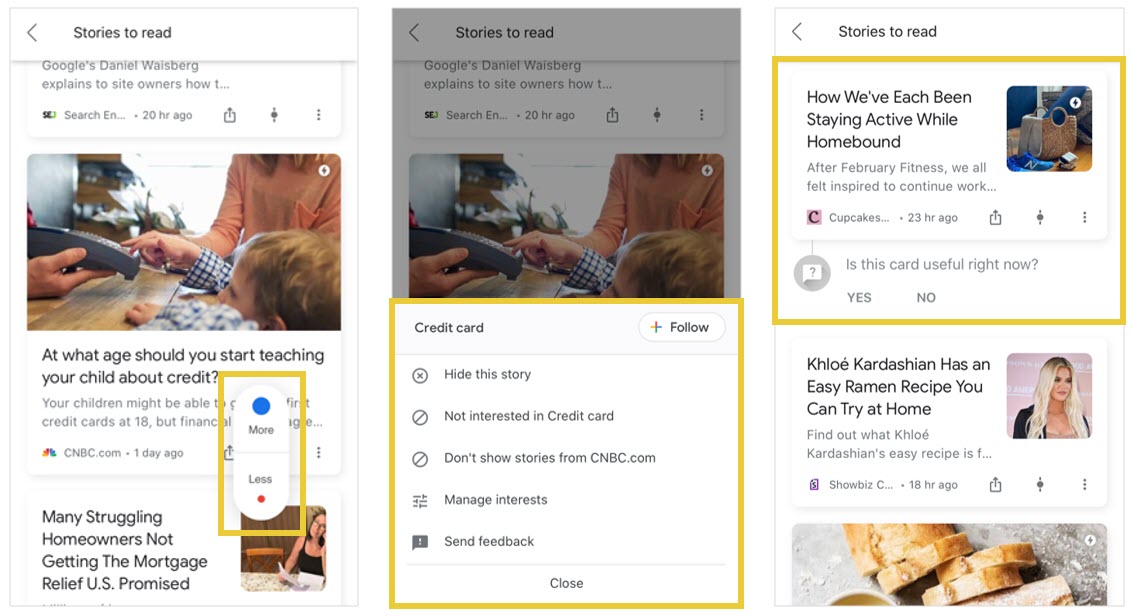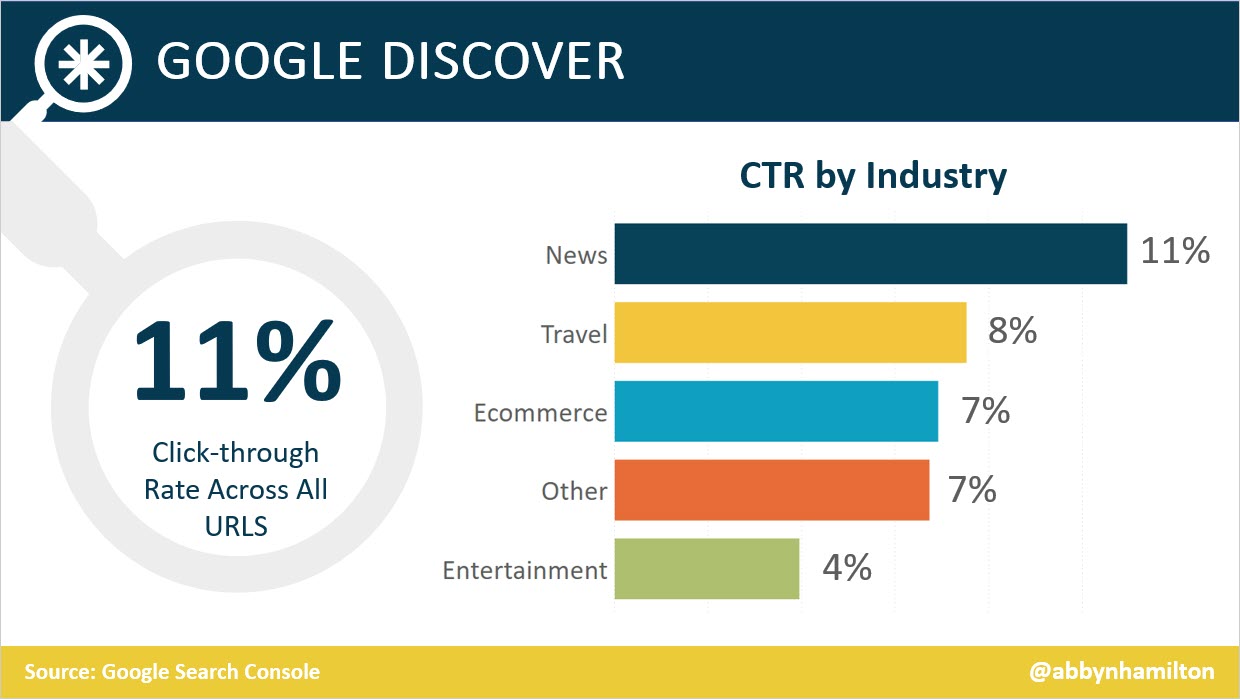As many webmasters out there already know, Google Discover serves new and interesting content before a user enters a search query. Discover is perhaps one of the best tools that Google has in its inventory right now.
It’s responsible for selecting articles that may be relevant depending on what we visit. And then include them in your search engine within the app. Thus regulating the depth of traffic on the most popular websites or ones that have attractive content.
Maybe that’s why some media trying to “ski” in Discover turns to articles with misleading or straightforward headlines to force users to click. But, Google is becoming more sensitive about it. And it seems that it will soon allow us to put an order in all this confusion. Be that as it may, you can find an already testing beta tool to report this type of content.
What Is Google Discover?
How does Google Discover work?
Below, let’s have a look at how sites from all industries can leverage Google Discover. According to the product announcement, two primary mechanisms are used. To determine what content is displayed in Google Discover like when:
- Using Google News AI/ML to bring a variety of perspectives on the latest news.
- Using the Topic Layer in the Knowledge Graph to understand user interests and how they progress over time.
While deemed by Google as the latest innovation in “query less search”, understanding of the individual user replaces the understanding of a singular query. Thus, the user becomes the central focus in Discover.
Google Discover automatically shows personalized content based on a user’s search history, app activity, browser history, and location. Whereby, location is dependent on your Google account set up and privacy settings.
Google Discover uses your information to identify and display topics Google believes will be relevant for you, known as “interests”.
What’s interesting,
To gain a deeper understanding of Google Discover Interests, I looked at over 700 Google Discover interests (provided by members of the best SEO tactics community). While this is an extraordinarily small sample size in comparison to all potential interests, there were a few notable observations.
For instance, interests related to Sports & Entertainment were the Most Prevalent. While the Discover feed is primarily focused on who former Bachelor Peter Weber is dating, I imagine other’s feeds are full of the latest sports updates.
In addition, it’s largely focused on Hobbies & Activities. Whatever you do in your pastime – whether it be baking or beekeeping – you’re likely to see content on your favorite after-work activities. Not to mention, brands also had a Strong Presence.
Almost every submission included specific brands or local businesses. While Discover aims to suggest new content to users, it still remembers your go-to stores and restaurants. And when it comes to SEO, it has its own Category. And in a real sense, we love SEO so much, that it got its own category.
What about the user input?
By all means, users can also provide direct feedback to further customize their feed. By following or unfollowing topics, selecting “show more” or “show less”, and choosing not to see content from certain publishers.

Occasionally, Google will directly prompt the user for feedback.
Isn’t Google Discover Just News?
Well, kind of. Now that one of the Google Discover goals is to serve fresh content and scrolling through the Discover feed, it is mostly news.
But, when clients from other industries started seeing Discover traffic in Google Search Console (GSC), it was time to investigate. I analyzed 12 months of Google Discover traffic to over 11,000 URLs from 62 domains. Of those 11,000 URLs, 46% were from news sites while 44% were from ecommerce sites.
Then, 7% were from entertainment sites while 2% were from travel sites. The remaining 1% were from other industries. Including, B2B, Automotive, Education, Finance, and Health. Below are more elaborations of my research finding;
1. Off all, News sites received 99% of clicks
While news accounted for less than half (46%) of URLs analyzed, it received 99% of Discover clicks and got significantly more clicks per page. One news domain in the analysis saw over 30% of its total web traffic coming from Discover.
Other publishers have reported that Google Discover drove more traffic than organic search in some months. It’s likely that news content is shown to a large, broad audience, while content from other industries are targeted to smaller audiences based on specific interests.
Google emphasizes this idea in the announcement of Google Discover, stating: “When It comes to news, we believe it’s important that everyone has access to the same information.” So, Google Discover is a major traffic driver for news publishers and can be used to reach a large, broad audience.
2. Blog posts are prevalent across all other industries
For non-news sites, the remaining 1% of clicks (still totaling over 1 million in the past 12 months) were dispersed across different types of content. The most prevalent type of content across industries was blog posts.

Blog topics that were displayed in Google Discover were highly relevant to specific interests/hobbies, such as hiking, makeup, and nutrition. Additionally:
- 49% of clicks to ecommerce sites went to product pages, which included both product category and product detail pages.
- Entertainment saw the largest percentage of clicks (16%) to pages with a video as the primary content (i.e., cast interviews, movie trailers).
- Special offers, mostly travel or hotel deals with limited time/availability pricing, accounted for the largest percentage of clicks to travel sites (53%).
This means that non-news content is heavily interest-focused. And will likely be displayed to a smaller, more targeted audience.
3. Typically, the Google Discover Content has a short shelf-life
Aligned with Discover’s focus on delivering fresh content, most of the URLs in this study only received traffic for 3-4 days. With most of that traffic occurring 1-2 days after publishing.
However, some more mature, evergreen content was able to drive longer-term traffic. This is the result of Google Discover serving evergreen content to meet new or evolving user interests.

In the instances where I’ve seen more mature, evergreen content appearing in my personal Discover feed, I was searching similar topics 2-3 days prior. Meaning, most pages in Discover have a short shelf-life, around 3-4 days, but evergreen content can drive longer-term traffic.
4. Uniquely, Users Respond well to Google Discover Content
One of the first things that stuck out about Google Discover was a high click-through rate (CTR), 11% across all pages analyzed.
Excluding news sites (which accounted for most of the data), the average CTR was 6%. Looking at the same 62 domains, the CTR from traditional search was 4%.

Unfortunately, these numbers can’t be directly compared as CTR is calculated as Clicks ÷ Impressions = CTR.
While impressions are measured differently in Discover than in traditional search. Here’s how:
- Search impressions are recorded for a URL when a user opens a search results page containing the URL (even if the result is not scrolled into view).
- Discover impressions are recorded only when a Discover card is scrolled into view
How do I connect with users of Google Discover?
Eventually, in traditional search, queries serve as a connection point between a user’s need and relevant content. For example, the user is hungry, searches [food near me], Google displays local restaurants.
Google Discover shows content before a user need is realized, “powered by the strength of the match between an article’s content and a user’s interests.” Without good keywords research and query reports, the traditional content creation process is limited – but there are still ways to increase chances of appearing in Discover.
It’s only accessible on mobile devices, so having a mobile-friendly site is obvious. But it’s always good to cover your bases by checking Google Search Console’s Mobile Usability Report and making sure there are no errors.
Google Search Console | Improve Your Rankings & CTR
In addition to that, focus your content around entities. Interests are entities, objects, or concepts that can be uniquely identified. They can be anything from general hobbies to niche interests, to specific brands and businesses.
Using the Entity Explorer by Marketer’s Center, you can view the relationships between entities and see what entities are associated with your brand, your industry, products, etc. Identify what entities serve as a connection point between your brand and your users.
It’s also important that you create content that is relevant, useful & interesting to your audience. Note that, you’re no longer bound by the keywords search volume. And in that case, embrace this newfound freedom.
What is Keywords Search? A Step-by-step Beginners Guide
Once you’ve identified connection points – get specific and go in-depth. Interest-based content is personalized, so write content that will resonate with your most passionate users. One way to do this is to identify intersections and relationships between topics. Like, the “best hotel resorts near Nairobi”, “running tips for beginners,” etc.
Particularly, this is a bonus point if you can tie content into current events. For example, this blog post from REI focuses on outdoor recreation, which is closely tied to REI’s products and their audience’s interests. It was published just before interest in “social distancing” peaked.
Aside from quality content creation, your users will find interesting, the best way to boost content on Discover is to use large, high-quality images that are at least 1,200 pixels wide. According to Google’s data, Discover cards with large images experienced a 5% increase in click-through rate.
Why is Video Marketing important?
It’s important to remember, videos have a huge presence in Google Discover. And this aligns with Google’s shift in focus from text to more visual ways of finding information.
While videos made up only 17% of the content in this analysis, this doesn’t include data for YouTube. Now that it hosts a majority of videos appearing in Google Discover.
It may be hard to measure, but creating engaging videos and optimizing your YouTube channel could help increase your brand’s presence in Google Discover. As well as in traditional search too, as 19% of desktop search results include video carousels and 92% of those videos come from YouTube.
Other More Related Resources:
- Return On Marketing Investment (ROMI) | Marketers Guide
- Web Advertising Networks | Top 20 Monetization Platforms
- Landing Page | A Beginner’s Guide for SEO Webmasters
- What is Brand Management? Step-by-step Marketers Guide
- What is Business Blogging? A Simplified Webmaster Guide
Finally, as can be seen, Google Discover is a personalized content feed. With the ability to understand user interests and how they progress over time.
News sites receive the most clicks from Google Discover. But it’s more than just news – all industries can leverage Google Discover to connect with users. Fresh content has a higher chance of appearing in Discover, but some evergreen pieces can drive long-term traffic.
See more information details about Google Discover: An Image Could Be Worth 1,000 Clicks [Case Study]. Don’t forget to Contact Us for more help or even donate to support our projects here.





